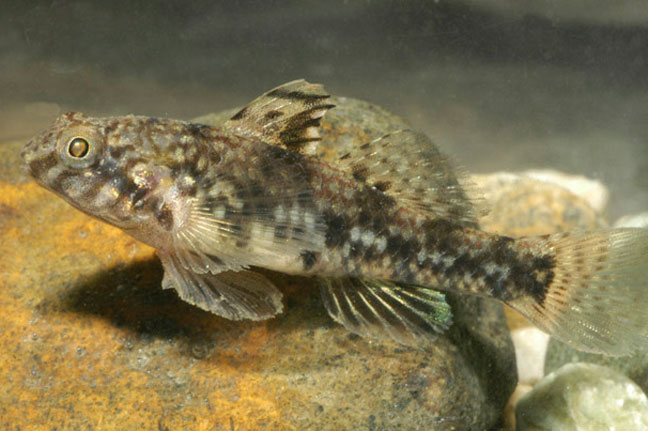Speckled Goby, Redigobius bikolanus (Herre 1927)

Speckled Goby, Redigobius bikolanus. Source: Gerald R. Allen. License: All rights reserved
Video of Speckled Goby (Redigobius bikolanus) embryos.
Speckled Goby, Redigobius bikolanus (Herre 1927)
More Info
|
Distribution |
Shark Bay, Western Australia, and Cape York, Queensland, to northern New South Wales. Records from the Northern Territory are based on misidentified Redigobius nanus, and some east coast records may also be of that species. Elsewhere the species occurs in the tropical, Indo-west-central Pacific. Inhabits brackish mangrove estuaries and the lower reaches of freshwater rivers with mud, sand, rock or silt bottoms. |
|
Features |
Dorsal fin VI + 1, 6-8; Anal fin I, 6-8; Caudal fin (segmented rays) 17; Pectoral fin 14-18; Pelvic fin I, 5; TRB 7-9; Vertebrae 11 + 15 = 26. Body compressed. Head somewhat compressed; interorbital narrow, flat. Anterior nostril in short tube, close to edge of upper lip. Mouth terminal, slightly oblique, usually reach well past rear of eye in adult males, and to below mid-eye in females; tongue tip rounded to truncate; gill openings narrow, reaching to just below operculum; pectoral girdle smooth or with low fleshy flange, occasionally with rudimentary knobs or lobes on anterior edge of cleithrum. Body scales ctenoid, lateral series 21-27; scales cycloid before first dorsal fin, on operculum, pectoral fin bases and area before ventral fins; top of head scaled forward to close behind eyes, predorsal scales large, 5-8. Two dorsal fins, first dorsal pointed, with triangular margin, first spine longest and may be filamentous in males, second dorsal and anal fins short-based, pointed posteriorly; caudal fin with rounded margin. Pectoral fins long, reaching to above anal fin origin, margin rounded to slightly pointed. Pelvic fins rounded, fused to form cup-shaped disc. |
|
Size |
To around 4.2 cm SL. |
|
Colour |
Head and body pale grey to whitish with scale margins outlined in dark brown or blackish, forming network pattern; side of body with series of five dark brown bars or X-shaped blotches along mid-lateral line; blackish, slightly oblique, narrow bar on side of body, extending from below first dorsal fin ventrally to mid-line of belly; second blackish narrow bar present on lower half of body, bar joining its counterpart just behind anus; four characteristic blackish spots running along mid-ventral line of anal fin and caudal peduncle; base of caudal fin with two short brown dark brown blotches or horizontal bars, arranged one above the other on either side of middle of fin base, with small brown central blotch on mid-base. First dorsal fin transparent with round to oval black spot posteriorly and two dusky to blackish horizontal stripes, ventral-most running anteriorly from black spot and ending in small dark brown to blackish spot on anterior face of first spine, upper stripe narrower anteriorly running along middle to upper third of fin and ending in similar blackish spot on first spine. Second dorsal and anal fins transparent with dark brown to greyish streaks and spotting, which may form lines in second dorsal fin. Caudal fin transparent with three to six rows of fine dark spots and speckling. |
|
Feeding |
Omnivorous, feeding on aquatic insects, microcrustaceans and algae. |
|
Biology |
This species is able to breed in freshwater as populations exist in lakes and reaches of rivers above barriers (e.g. Fitzroy barrage in Australia). This species has also been successfully bred in freshwater in captivity. Oviparous, benthic spawners. Eggs are adhesive, with around 1,000 eggs laid over several hours. Very small larvae hatch after 7-12 days. |
|
Etymology |
The specific name refers to the Bicol region of the Philippines, where type locality occurs, –anus (= belonging to). |
|
Species Citation |
Vaimosa bikolana Herre 1927, Monogr. Bur. Sci. Manila 23: 151, pl. 11(2). Type locality: Creek at barrio Puru, Legaspi, Albay Province, Philippines. |
|
Author |
Gomon, M.F. & Bray, D.J. 2021 |
|
Resources |
Speckled Goby, Redigobius bikolanus (Herre 1927)
References
Akihito, P. & Meguro, K. 1975. On a goby Redigobius bikolanus. Japanese Journal of Ichthyology 22(1): 49-52
Allen, G.R. 1989. Freshwater Fishes of Australia. Neptune, New Jersey : T.F.H. Publications 240 pp., 63 pls.
Allen, G.R., Midgley, S.H. & Allen, M. 2002. Field Guide to the Freshwater Fishes of Australia. Perth : Western Australian Museum 394 pp.
De Vis, C.W. 1884. New fishes in the Queensland Museum. No. 4. Proceedings of the Linnean Society of New South Wales 1 9(3): 685-698 (described from Moreton Bay, Queensland, as Gobius flavescens, a junior homonym of Gobius flavescens Fabricius, 1779.
Herre, A.W. 1927. Gobies of the Philippines and China Seas. Monographs of the Bureau of Science. Manila 23: 1-352 pls 1-30
Johnson, J.W. 2010. Fishes of the Moreton Bay Marine Park and adjacent continental shelf waters, Queensland, Australia. pp. 299-353 in Davie, P.J.F. & Phillips, J.A. Proceedings of the Thirteenth International Marine Biological Workshop, The Marine Fauna and Flora of Moreton Bay. Memoirs of the Queensland Museum 54(3)
Larson, H.K. 2001. A revision of the gobiid fish genus Mugilogobius (Teleostei: Gobioidei), and its systematic placement. Records of the Western Australian Museum, Supplement 62: 1-233
Larson, H.K. 2010. A review of the gobiid fish genus Redigobius (Teleostei: Gobionellinae), with descriptiions of two new species. Ichthyological Explorations of Freshwater 21(2): 123–191
Larson, H. 2019. Redigobius bikolanus. The IUCN Red List of Threatened Species 2019: e.T19388A58300564. https://dx.doi.org/10.2305/IUCN.UK.2019-2.RLTS.T19388A58300564.en. Accessed on 16 December 2021.
McCulloch, A.R. & Ogilby, J.D. 1919. Some Australian fishes of the family Gobiidae. Records of the Australian Museum 12(10): 193-291 figs 31-37 (as Gobius flavescens)
Merrick, J.R. & Schmida, G.E. 1984. Australian Freshwater Fishes Biology and Management. Sydney : J.R. Merrick 409 pp. figs 280 col. figs.
Pusey, B.J., Kennard, M.J. & Arthington, A.H. 2004. Freshwater Fishes of North-eastern Australia. Collingwood, Victoria : CSIRO Publishing 684 pp.
Whitley, G.P. 1930. Additions to the checklist of the fishes of New South Wales No. 3. The Australian Zoologist 6(2): 117-123 fig. 14(as Parvigobius immeritus, nom. nov. for Gobius flavescens De Vis, 1884).



